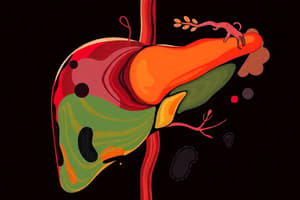Podcast
Questions and Answers
What organ stores bile?
What organ stores bile?
- Pancreas
- Liver
- Spleen
- Gall Bladder (correct)
Which of the following organs produces insulin?
Which of the following organs produces insulin?
- Pancreas (correct)
- Gall Bladder
- Liver
- Thyroid Gland
What is the primary function of the small intestine?
What is the primary function of the small intestine?
- Filters blood
- Absorbs waste
- Pumps blood
- Continues the process of digestion and absorbs nutrients (correct)
The spleen destroys old and dead red blood cells.
The spleen destroys old and dead red blood cells.
What does the liver convert excess glucose into?
What does the liver convert excess glucose into?
The ______ separates the thorax from the abdomen.
The ______ separates the thorax from the abdomen.
What does the thymus gland play a vital role in?
What does the thymus gland play a vital role in?
How many lobes does a fetal pig have?
How many lobes does a fetal pig have?
What is the function of the umbilical cord?
What is the function of the umbilical cord?
What is the function of the epiglottis?
What is the function of the epiglottis?
Are mammary papillae found in both males and female pigs?
Are mammary papillae found in both males and female pigs?
Distinguish between the functions of the small intestines and the large intestines.
Distinguish between the functions of the small intestines and the large intestines.
Flashcards are hidden until you start studying
Study Notes
Gall Bladder
- Stores bile, a mix of fluids, fat, and cholesterol, aiding in fat digestion.
- Delivers bile into the small intestine, where most chemical digestion and nutrient absorption occur.
Pancreas
- Produces digestive juices and hormones, including insulin.
- Vital for digestion and regulation of blood sugar levels.
Liver
- Produces bile and converts excess glucose to glycogen.
- Filters blood from the digestive tract, detoxifies chemicals, and metabolizes drugs.
- Synthesizes proteins essential for blood clotting and various bodily functions.
Spleen
- Destroys old and damaged red blood cells, serving as a blood filter in the immune system.
- Recycles red blood cells and stores platelets and white blood cells.
- Contributes to fighting bacteria responsible for pneumonia and meningitis.
Small Intestines
- Main site for chemical digestion and nutrient absorption.
- Continues digestion from the mouth and stomach, preparing food for the large intestine.
Thyroid Gland
- Regulates metabolic rate and influences growth and development.
- Secretes various hormones vital for metabolism, temperature regulation, and calcium balance.
Large Intestines
- Absorbs water and eliminates solid waste from the body.
- Completes food digestion, taking approximately 16 hours from the ileocecal valve to the anus.
Diaphragm
- Muscular dome-shaped structure separating thoracic and abdominal cavities.
- Essential for respiration, as it allows lung inflation by creating a seal with the ribs.
Heart
- Pumps blood throughout the body, comprising four chambers regulated by valves.
- Critical for maintaining circulation and delivering nutrients and oxygen to tissues.
Thymus Gland
- Plays a key role in the body's immune response by training T-lymphocytes.
- T cells protect against bacteria, viruses, and fungi, enhancing immune defense.
Fetal Pig Lobes
- Consists of four lobes, which is a characteristic of its anatomical structure.
Umbilical Cord
- Transports blood to the placenta and returns deoxygenated blood to the fetus.
Epiglottis
- A flap of elastic cartilage that prevents food from entering the larynx during swallowing.
- Remains open during breathing to allow air passage into the larynx.
Mammary Papillae
- Present in both male and female pigs, serving a nursing function in females.
Functions of Small and Large Intestines
- Small intestines focus on nutrient absorption, while large intestines primarily absorb water and expel waste.
Studying That Suits You
Use AI to generate personalized quizzes and flashcards to suit your learning preferences.




